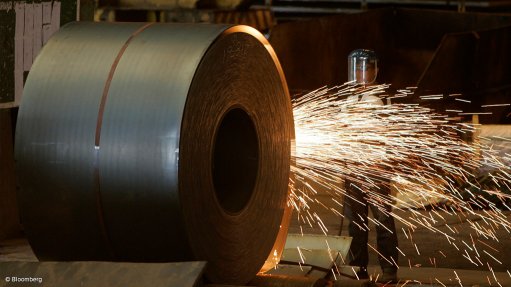
Photo by: Bloomberg
The Steel and Engineering Industries Federation of Southern Africa (Seifsa) has called on government to extend the protection of the metals and engineering sector throughout the value chain.
Seifsa, which supported the introduction of a 10% tariff on imported steel by the International Trade Administration Commission of South Africa, warned that extra caution must be taken to ensure that downstream steel producers were not negatively affected.
Seifsa chief economist Henk Langenhoven said government should consider possible further protection measures across the entire value chain.
“Price distortions of imported metals and engineering products are prevalent throughout the value chain, owing to subsidies and incentives given to manufacturers in some of the exporting countries, as well as market strategies to clear massive excess inventories that arose out of surplus production capacity worldwide.
“It is Seifsa’s view that the entire value chain should be analysed and appropriate protection measures put in place to counter the wholesale destruction of the sector’s manufacturing capacity,” he added.
The current round of tariff announcements for basic steel products was the result of a difficult trade-off between losing the whole sector – which represented 1.5% of the country’s gross domestic product, R30-billion in foreign exchange earnings and employed 30 000 people – and causing
some distortions of its own through the tariffs.
The tariff protection was given with very strict conditions regarding domestic price increases and other obligations from the domestic steel industry.
Langenhoven pointed out that fear did exist, however, that prices would increase, thus harming the downstream value chain, and that the measures would be insufficient to stop the bleeding. “Both results are unsatisfactory,” he said.
“The reality is that companies in the downstream value chain are generally smaller than those in the upstream iron and steel industry. All parties understand this.
“The Trade and Industry and Economic Development Ministers, as well as industry leaders within the basic iron and steel sector, have considered this and are keen to understand the impact on the ground as producers stand to lose their markets if a proper balance is not attained,” he elaborated.
Seifsa, in collaboration with other industry associations, had embarked on an intensive process of analysis to understand the actual situation. The tariffs currently in place within the downstream value chain were interrogated, as well as the impact the new measures may have on the companies.
Langenhoven said that, in the bigger scheme of things, tariff protection remained a short-term solution, with potential side effects.
“In the long run, the sector needs to adjust structurally to the new environment and to exploit export market opportunities better, when these recover. It must also be allowed to supply domestic products to domestic infrastructure projects to a larger degree than is the case now.
“Domestic demand from the mining sector will only come after more stability, both in commodity markets internationally and labour relations internally, sets in,” he highlighted.